Page 138 of 324
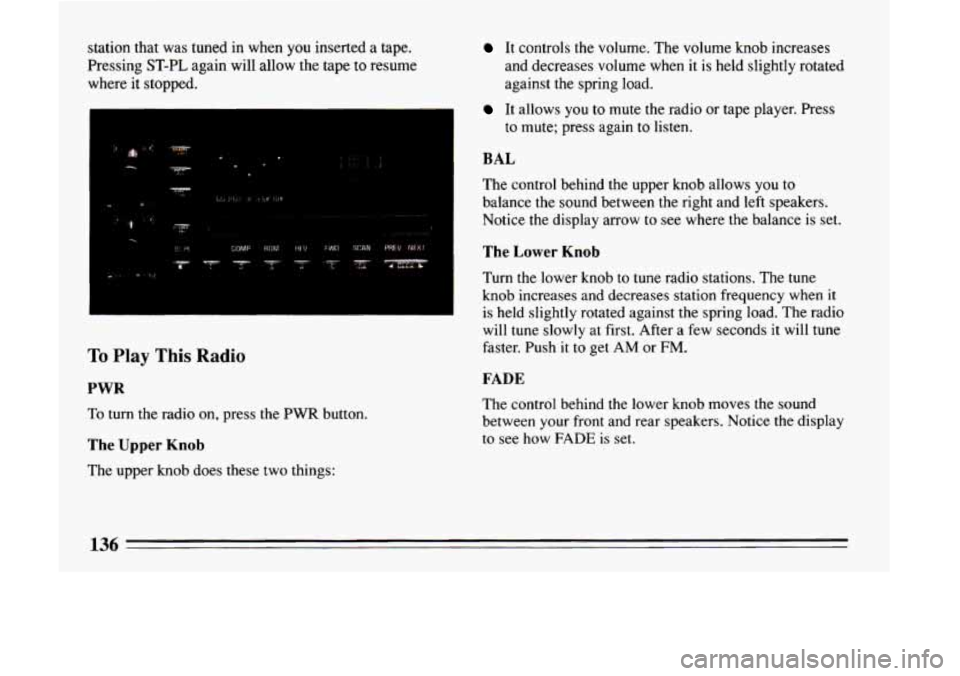
station that was tuned in when you inserted a tape.
Pressing ST-PL again will allow the
tape to resume
where it stopped.
To Play This Radio
PWR
To turn the radio on, press the PWR button.
The Upper Knob
The upper knob does these two things:
It controls the volume. The volume knob increases
and decreases volume when it is held slightly rotated
against the spring load.
It allows you to mute the radio or tape player. Press
to mute; press again to listen.
BAL
The control behind the upper knob allows you to
balance
the sound between the right and left speakers.
Notice
the display arrow to see where the balance is set.
The Lower Knob
Turn the lower knob to tune radio stations. The tune
knob increases and decreases station frequency when it
is held slightly rotated against the spring load. The radio
will tune slowly at first. After a few seconds it will tune
faster. Push it to get
AM or FM.
FADE
The control behind the lower knob moves the sound
between your front and rear speakers. Notice the display
to see how
FADE is set.
Page 143 of 324
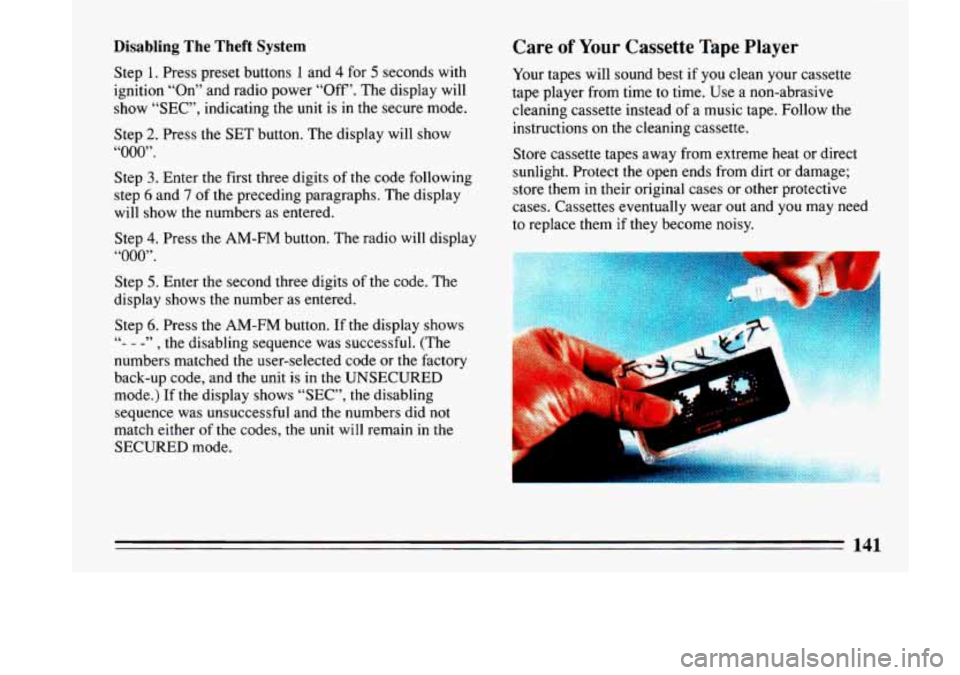
Disabling The Theft System
Step 1. Press preset buttons 1 and 4 for 5 seconds with
ignition “On” and radio power “Off’. The display will
show “SEC”, indicating the unit is in the secure mode.
Step
2. Press the SET button. The display will show
‘600097.
Step 3. Enter the first three digits of the code following
step
6 and 7 of the preceding paragraphs. The display
will show the numbers as entered.
Step
4. Press the AM-FM button. The radio will display
“000”.
Step 5. Enter the second three digits of the code. The
display shows the number as entered.
Step
6. Press the AM-FM button. If the display shows
- - -” , the disabling sequence was successful. (The
numbers matched the user-selected code or the factory
back-up code, and the unit is
in the UNSECURED
mode.) If
the display shows “SEC”, the disabling
sequence was unsuccessful and
the numbers did not
match either of the codes, the unit will remain in the
SECURED mode.
66
Care of Your Cassette Tape Player
Your tapes will sound best if you clean your cassette
tape player from time to time. Use a non-abrasive
cleaning cassette instead of a music tape. Follow the
instructions on the cleaning cassette.
Store cassette tapes away from extreme heat or direct
sunlight. Protect the open ends from dirt or damage;
store them in their original cases or other protective
cases. Cassettes eventually wear out and you may need
to replace them
if they become noisy.
141
Page 144 of 324
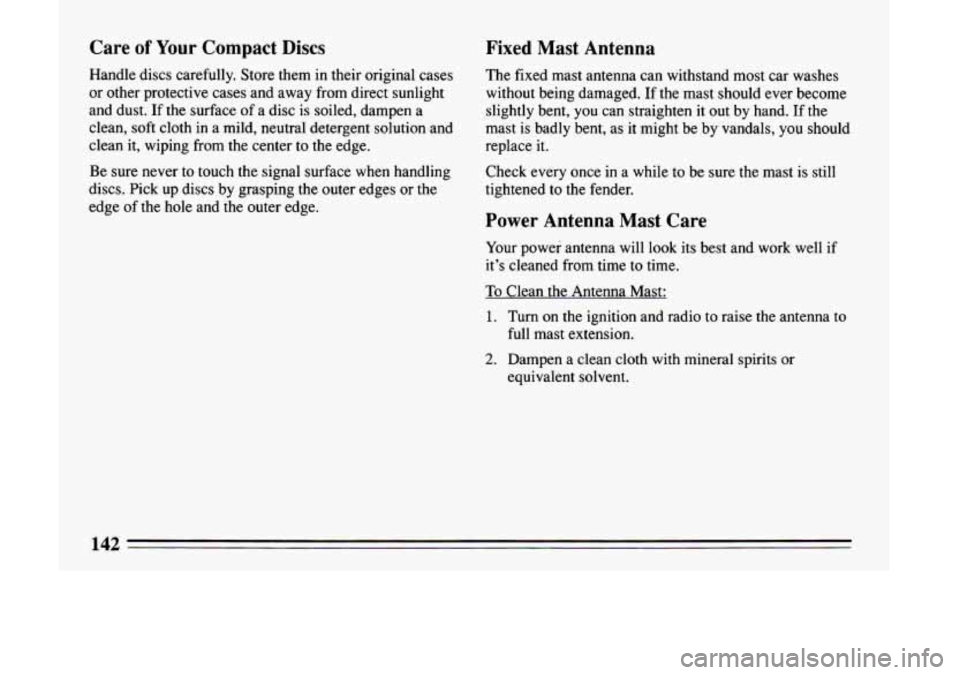
Care of Your Compact Discs
Handle discs carefully. Store them in their original cases
or other protective cases and away from direct sunlight
and dust.
If the surface of a disc is soiled, dampen a
clean, soft cloth in a mild, neutral detergent solution and
clean it, wiping from the center to the edge.
Be sure never to touch the signal surface when handling
discs. Pick up discs by grasping the outer edges or
the
edge of the hole and the outer edge.
Fixed Mast Antenna
The fixed mast antenna can withstand most car washes
without being damaged. If the mast should ever become
slightly bent, you can straighten it out by hand. If the
mast is badly bent, as it might be by vandals, you should
replace it.
Check every once
in a while to be sure the mast is still
tightened to the fender.
Power Antenna Mast Care
Your power antenna will look its best and work well if
it’s cleaned from time to time.
To Clean the Antenna Mast:
1. Turn on the ignition and radio to raise the antenna to
2. Dampen a clean cloth with mineral spirits or
full mast extension.
equivalent solvent.
1 A3
Page 154 of 324
Traffic Lights Some traffic lights also use red arrows to signify that
you must stop before turning on red.
REVERSIBLE
LANE ON
LANE
ROADWAY MULTI-
x
-.
-.
We’re
all familiar with traffic lights or stop lights. Often
green arrows are being used in the lights for improved
traffic control. On some multilane roads, green arrows
light up, indicating that traffic in one or more lanes can
move or make
a turn. Green arrows don’t mean “go no
matter what.” You’ll still need
to proceed with caution,
yielding
the right of way to pedestrians and sometimes
to other vehicles. Many city
roads and expressways, and even bridges, use
reversible-lane traffic control during rush hours.
A red X
light above a lane means no driving in that lane at that
time.
A green arrow means you may dfive in that lane.
Look for the signs posted to warn drivers what hours
and days these systems are
in effect.
152
-
Page 155 of 324
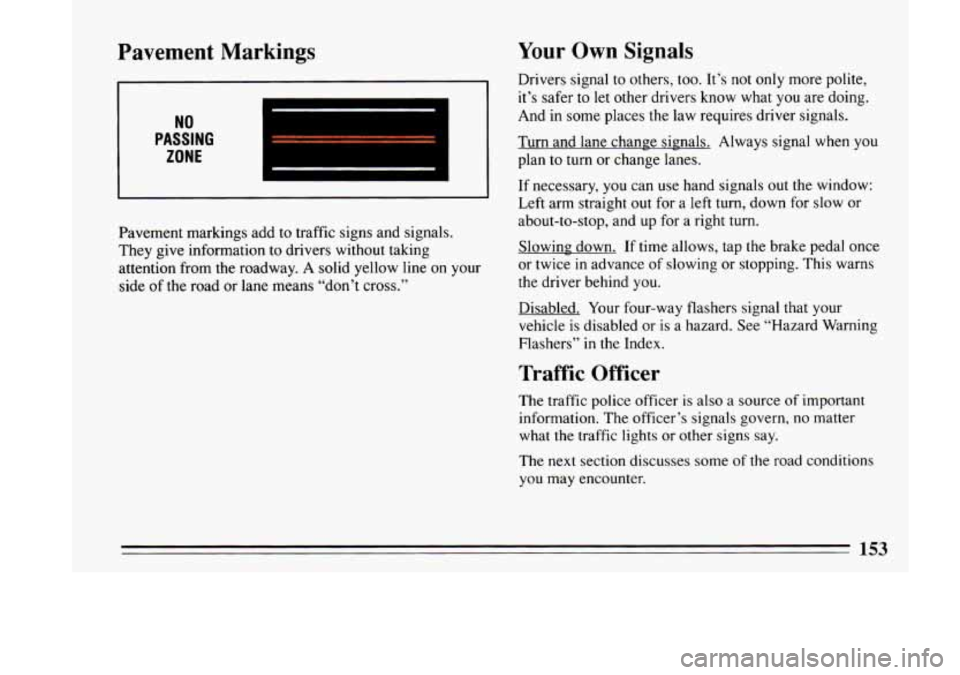
Pavement Markings
NO
PASSING
ZONE
Pavement markings add to traffic signs and signals.
They give information to drivers without taking
attention from the roadway. A solid yellow line on your
side
of the road or lane means “don’t cross.’’
Your Own Signals
Drivers signal to others, too. It’s not only more polite,
it’s safer to let other drivers know what
you are doing.
And in some places the law requires driver signals.
Turn and
lane change signals. Always signal when you
plan to turn or change lanes.
If necessary, you can use hand signals
out the window:
Left arm straight out for a left turn, down for slow or
about-to-stop, and
up for a right turn.
Slowinn down. If time allows, tap the brake pedal once
or twice in advance of slowing or stopping. This warns
the driver behind
you.
Disabled. Your four-way flashers signal that your
vehicle is disabled
or is a hazard. See “Hazard Warning
Flashers” in the Index.
Traffic Officer
The traffic police officer is also a source of important
information. The officer’s signals govern, no matter
what the traffic lights or other signs say.
The next section discusses some
of the road conditions
you may encounter.
153
Page 158 of 324
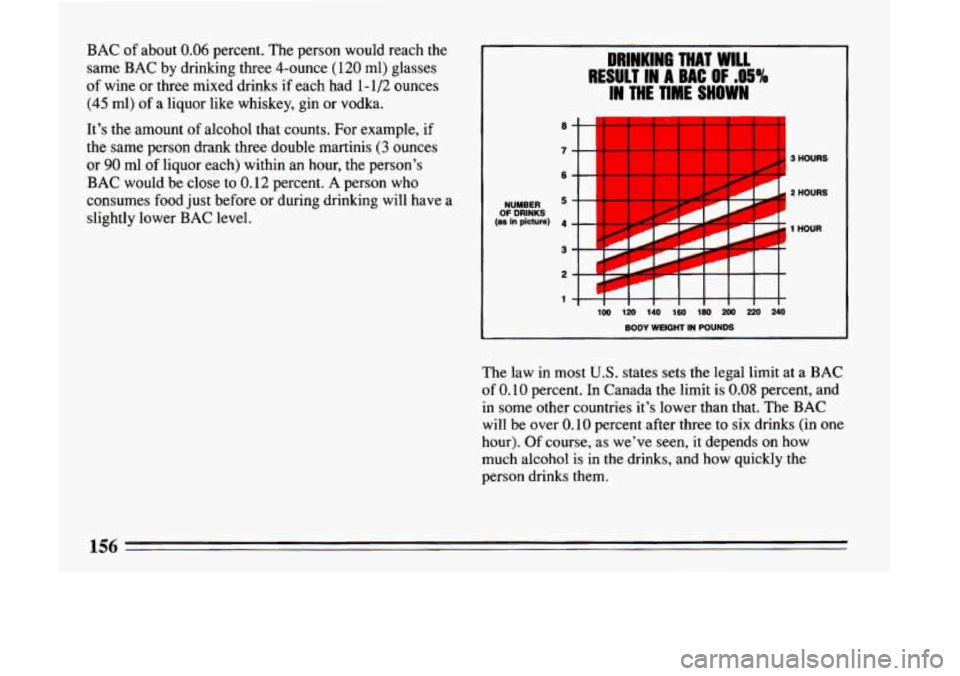
BAC of about 0.06 percent. The person would reach the
same BAC by drinking three 4-ounce
(120 ml) glasses
of wine or three mixed drinks if each had
1-1/2 ounces
(45 ml) of a liquor like whiskey, gin or vodka.
It’s the amount
of alcohol that counts. For example, if
the same person drank three double martinis (3 ounces
or
90 ml of liquor each) within an hour, the person’s
BAC would be close to
0.12 percent. A person who
consumes food just before or during drinking will have a
slightly lower BAC level.
D
Rr -.
OF DRINKS (as in picture) 4
5 THAT WILL
IN THE TIME SHOWN
r IN A BAC OF .05%
I
3 HOURS
’ - ? HOURS
‘ 1 HOUR
100 120 140 160 180 200 220 240
BODY WEIGHT IN POUNDS
The law in most U.S. states sets the legal limit at a BAC
of
0.10 percent. In Canada the limit is 0.08 percent, and
in some other countries it’s lower than that. The BAC
will be over 0.10 percent after three to six drinks (in one
hour).
Of course, as we’ve seen, it depends on how
much alcohol
is in the drinks, and how quickly the
person drinks them.
Page 161 of 324
0 Avoid needless heavy braking. Some people drive in
spurts
-- heavy acceleration followed by heavy
braking
-- rather than keeping pace with traffic. This
is a mistake. Your brakes may not have time to cool
between hard stops. Your brakes will wear
out much
faster
if you do a lot of heavy braking.
0 Don’t “ride” the brakes by letting your left foot rest
lightly
on the brake pedal while driving.
I A CAUTION: -’+
“Riding” your brakes can cause them to overheat
to the point that they won’t work well. You might
not be able to stop your vehicfe
in time to avoid
an accident. If you “ride’’ your brakes, they will
get so hot they will iequire a lot of pedal force to
slow you down. Avoid “riding” the brakes.
Riding” the brakes wears them
out much
I You would need costly brake replacement much
If you keep pace with the traffic and allow realistic
following distances,
you will eliminate a lot of
unnecessary braking. That means better braking and
longer brake life.
159
Page 162 of 324

0 If your engine ever stops while you’re driving, brake
normally but don’t pump your brakes.
If you do, the
pedal may get harder to push down.
If your engine
stops, you will still have some power brake assist.
But
you will use it when you brake. Once the power assist
is used up, it may take longer to stop and the brake
pedal will be harder to push.
Anti-Lock Brakes (ABS)
Your Buick has an advanced electronic braking system
that will help prevent skidding.
This light
on the instrument panel will go on when you
start your vehicle.
See “Anti-lock Brake System Warning Light”
in the
Index.
@
ANTI
LOCK
‘1 ”. j ’ ;I
- -’ y- ..-
a,
rn
e,
Here’s how anti-lock works. Let’s say the road is wet.
You’re. driving safely. Suddenly an animal jumps
out in
front
of you.
You slam on the brakes. Here’s what happens with ABS.
A computer senses that wheels are slowing down. The
computer separately works the brakes at each front
wheel and at the rear wheels.
The anti-lock system can change the brake pressure
faster than any driver could. The computer
is
programmed to make the most of available tire and road
conditions.
160